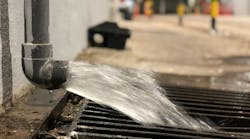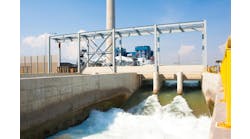Water serves a crucial function in manufacturing, whether it's employed in processing, heating, cooling, cleaning or as an essential ingredient. However, 90% or more of water intake in industrial processes ends up as wastewater.(1) While often regarded as creating undesirable costs, treating wastewater for reuse or before being discharged into the environment can be an opportunity. Consider that more industries around the world face sustainability mandates from consumers and regulators as well as rising energy and material costs. By tackling toxic wastewater, chemical processing companies can reduce their water footprint and increase water reuse, leading to better overall water management.
Water reuse is particularly important for chemical processing plants operating in areas where water scarcity and drought pose threats to production. In addition, toxic discharges can impact a company’s reputation, with public demands for accountability and actions to remedy the situation, including better environmental protections.
But cost is always a factor for chemical processing organizations when trying to manage wastewater. Ultimately, minimizing wastewater loading is the best way to reduce treatment expenses. Wastewater treatment may include a combination of biological, chemical and physical treatment barriers based on the flow and contamination load, as well as the discharge quality requirements. Investment into onsite water reclamation can quickly offset discharge fines and water intake costs. This is where the overall water footprint and water costs across a plant come into play. Advanced treatment, such as ultraviolet (UV), ion exchange, activated carbon or reverse osmosis, is often required to enable reuse on-site. The purpose for reclaimed water often determines the treatment requirements. Cooling water, for instance, has lower quality requirements than boiler feed water.
Strategies and Practices for Water Treatment
Guidelines aimed at limiting emissions from manufacturing encourage industry to operate more efficiently and sustainably. One example is the Industrial Emissions Directive for European Union members, which suggests best available techniques (BAT) and associated emissions levels (AEL) to guide sectors on how to achieve not only compliance but also improvement. Similarly, the U.S. Clean Water Act is constantly evolving to drive wastewater treatment improvements to avoid pollution or toxic events. At a corporate level, many companies are now publishing conservation projects, long-term water goals and progress updates. While some goals may be weaker than others, these measures hold companies accountable to shareholders, customers and their local communities.
One key BAT is to monitor key process parameters at critical locations. Previously, point of exit was the preferred monitoring location, but optimization and cost savings can only be truly achieved if monitoring is also added upstream. Identifying what contributes to wastewater loading and how that impacts wastewater treatment is critical for achieving discharge compliance.
Operators should create a water footprint map of the plant to identify areas of potential contamination or areas for potential optimization. They can then add monitoring points to the map to bring critical data to the forefront and enable water-treatment decisions. The footprint map can guide facilities to target current pain points and ensure they understand the purpose of the data. Gathering lab data across a facility is often a good starting point. If there are no changes across several process units, they can be considered insignificant, initially. But when treatment stages or processing steps result in significant water quality or quantity changes, operators should consider them to be critical control points.
To determine which parameters to monitor, plants can look at their onsite treatment and products, as well as their source water and discharge water qualities. For example, in chemical processing, basic or commodity chemicals include plastics and polymers. These are often building blocks for the energy industry and consumer products. Since raw materials are organic compounds, discharges from such chemical manufacturing can often be extremely high in organic loading or drastically change depending on production. This leads many manufacturers to design a buffer storage tank to handle high and low concentrations to meet compliance.
In specialty chemicals, materials are made of inorganics like nitrogen, sulfur or chlorine compounds. Sometimes, organic compounds from the environment or the processing can interfere with purity or interfere with processing efficiency. One example is chlor-alkali production, which uses saturated brine and membrane electrolysis to produce chlorine and related products. There is a risk of accumulation of organic contamination by recycling the brine. Organic contamination can foul the membrane systems and lead to unplanned maintenance. Tracking the contaminant can help protect membrane systems from damage and maintain productivity.
In addition to physical and basic chemical parameters like temperature, pressure, flow, pH, and conductivity, operators should consider how they affect process control, compliance and product quality. In terms of what is discharged to the environment, common parameters of concern include organic and inorganic matter and nutrients. Organic matter and nutrients (C, N, P) impact local environments through algal blooms and eutrophication and must be removed through treatment. That’s why it’s critical to monitor and remove organic contamination.
Measurement Methods
Many regions measure oxygen demand is to indicate organic content discharged to the environment. Biological oxygen demand (BOD) does this by measuring the biological degradation of compounds in a sample over five or more days. Here, precision and sensitivity are limited due to the interference from sanitizing and cleaning agents. Chemical oxygen demand (COD) uses a strong oxidant, sometimes toxic, to chemically break down compounds in a sample in two to three hours. COD is not selective to organics, though, and will include a subset of inorganics like nitrite, ammonia and sulfite. Ferrous compounds also affect the accuracy of COD measurements. This makes it difficult to make decisions that can be actionable in the process. For instance, if COD is high, it becomes hard to determine whether it’s from organics or ammonia. And if BOD in the effluent is insignificant, below 20 ppm due to repeatability and sensitivity issues, then a limit below 20 ppm is hard to ensure.
Total organic carbon (TOC) is the often preferred option to monitor wastewater because it does not rely on the use of toxic compounds and gives readings in a usable timeframe with suitable accuracy (~2-5%) and precision (~2-5%). While historical databases and permits are often written for COD, a site-specific assessment can be extremely valuable to move to TOC.
Total organic carbon (TOC) is the often preferred option to monitor wastewater because it does not rely on the use of toxic compounds and gives readings in a usable timeframe with suitable accuracy (~2-5%) and precision (~2-5%). While historical databases and permits are often written for COD, a site-specific assessment can be extremely valuable to move to TOC.
Operators determine TOC by oxidizing organics to carbon dioxide and then measuring the resulting carbon dioxide. There are several technologies to measure TOC, including TOC analyzers and TOC sensors that try to correlate to analyzers. The drawback of sensors is that while they can be faster, they have interferences, insufficient recovery of key compounds and only capture a portion of the organics.
TOC analyzers have different oxidation techniques and detection techniques that depend on the desired application. When measuring a return condensate stream intended to combine with boiler feed water and generate steam, the technology must track virtually ‘nothing’ in the sample. In this case, sensitivity and speed are key to detecting any deviation. For a different application like tracking load and contamination changes of influent wastewater, robustness is the key attribute required to handle salts, solids, inorganics, and high organic loading.
For all applications, equally important to the TOC measurement technology is the support once a TOC analyzer is in use and throughout a successful process monitoring program. Maintenance, additional parameters, verification and automation are all factors to consider in addition to performance. These factors must be accounted for when considering cost and water-saving efforts. The analytical tool is meant to help answer questions and drive decisions, so companies can benefit from the opportunity of seeing wastewater treatment optimization and even on-site reclaim.
Maximizing Compliance and Sustainability
Improved industrial water management offers chemical processing companies the opportunity to ensure compliance with changing regulations, improve their public image, satisfy consumer demands, promote a strong environmental and sustainable culture and reduce costs. To realize these benefits, companies must have a measure of how effective treatment is, whether they are in compliance and how efficient their processes are. In addition to wastewater optimization, organizations can learn about other potential improvements related to their water use through monitoring strategies. For example, they can use actual cleanliness data to improve chemical and water use rather than basing decisions on estimated cleaning time or the number of cycles. These data-driven decisions can help chemical processing companies avoid over-cleaning, minimize wasted product and conserve resources. They can also use these monitoring techniques to track water feeds to steam systems to protect equipment, such as heat exchangers and condensers, from harmful contaminants.
Getting control of industrial wastewater is beneficial for manufacturers across all industries. This is not only because of regulations and costs but also because of opportunities to improve operations and meet sustainability goals and consumer demands. Pressure, especially on consumer-facing industries, can be reduced by monitoring critical control points across a facility to enable better control of industrial wastewater. With improved technologies to track contamination, chemical processing companies can make rapid decisions to achieve compliance and take advantage of opportunities for onsite reclamation and reuse.
Resources
1. "Water for Chemicals: Market Trends and Forecasts," 2023-2030. Insight Report. Bluefield Research. September 2023.


